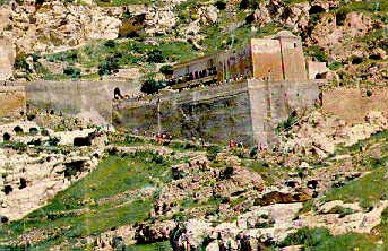The Deir is located about 70km north of Mosul in northern Iraq, situated directly above a large cave in the Alqush Mountain. It overlooks a valley called 'Gali al-deir', or “Valley of the Monastery”.
It is cared for by the Chaldean Church (previously The Church of the East).
The monastery was built in 640 AD with the assistance of two Ninevite princes who witnessed miraculous healing by Rabban Hurmiz.
Deir Rabban Hurmiz is the most famous and most visited monastery in Iraq. It was the holy seat of the Patriarch of the Assyrian Church of the East for several generations. Until a few years ago, the monastery was inaccessible by car and had neither electricity nor running water. The monks relied on mountain springs and oil lamps for everyday life. It was a well known center of learning and religion especially from the 10th to the 12th centuries.
The monastary was attacked by Mongols under the leadership of Tamerlane, and monastic life returned later on a smaller scale.
The monastery contains several wings including a church with several altars, a burial site for saints and patriarchs( Baith Sahdeh) , a library currently containing manuscripts dating back to 1497, 'Baith Sahdeh' or 'house of martyrs', 'Baith U'matha' or 'house of baptism', and over 40 small caves used by monks scattered all over the Alqush mountain. Some of the caves contain carved writings with historical details about the monastery. There are large rooms carved into the mountain, the largest is the dining room able to hold over 100 monks. This room is 55.75 Sq.M , 4.6M high, completely carved inside the mountain with vertical portions left uncarved to act as support beams.
The church contains the following altars:
1. The Raban Hurmiz Altar: The oldest and simplest in the monastery. The north and west walls are part of the mountain and the floor is made up of stone coffins. Includes stone carvings of 14 different types of crosses. The latter is a monolithic stone type with a center groove containing white sand called 'khnana'. This 'khnana' is sacred to Assyrian worshipers and is usually brought from burial sites of certain saints.
2. The Mar Antonios Altar: Situated east of the Rabban Hurmiz altar. This small (8x3 meters) room includes an altar with two finely carved boxes used to store the holy book, the cross, and various oils used in mass. The altar is made of white marble-like stone.
3. The Holy Trinity Altar: The largest of the monastery, and considered the formal church of the monastery. It contains Syriac carvings dating to the 15th century. This part of the monastery was renovated in several times, in 1485, 1667 (after an earth quake), 1817, 1846, 1849, 1930.
4. The Forty Martyrs Altar: Built in 1820.
5. The Patriarchal Burial Altar: Contains 9 graves of the patriarchs who led the Church of the East from 1497 to 1804
In 1653, the Kurds attacked the Monastery and the seat of the Patriarchy moved to Telkepeh (Telkaif) for a short period. Mar Elia returned to the monastery in 1714 and became the center of the Chaldean patriarch for four generations.
In 1722, over 60 monks fled the monastery after the attacks by the Kurdish leader Nader-Shah, and took refuge in the nearby Mar Mikha church in Alqush.
Monastic life returned once again in 1808. The monastery continued successfully until the Kurdish uprising in North Iraq between 1963-1974 which caused the monks and priest to vacate the mountain. The Chaldean Church was able to return to the monastery in 1975 and continues to care for it.



